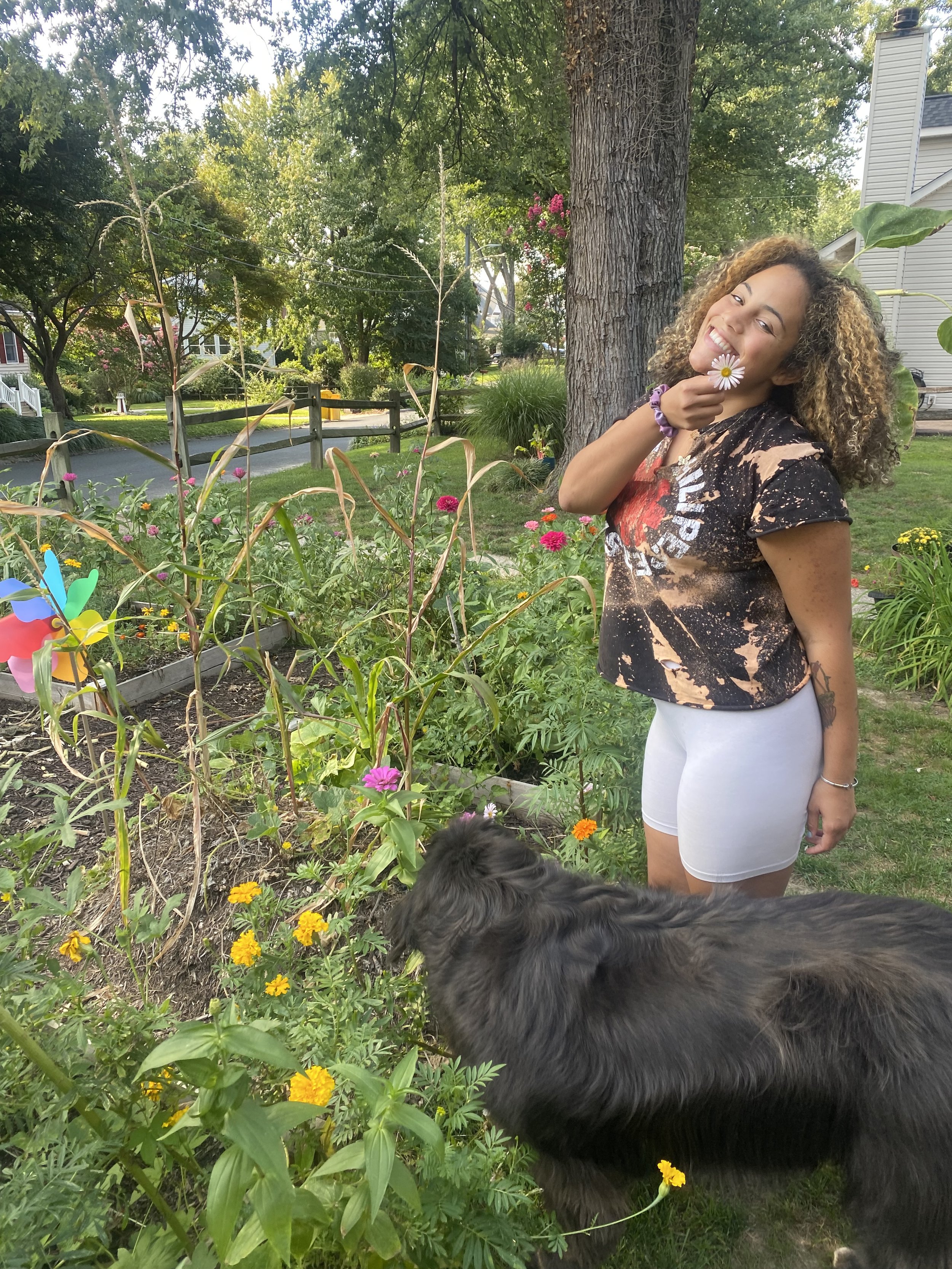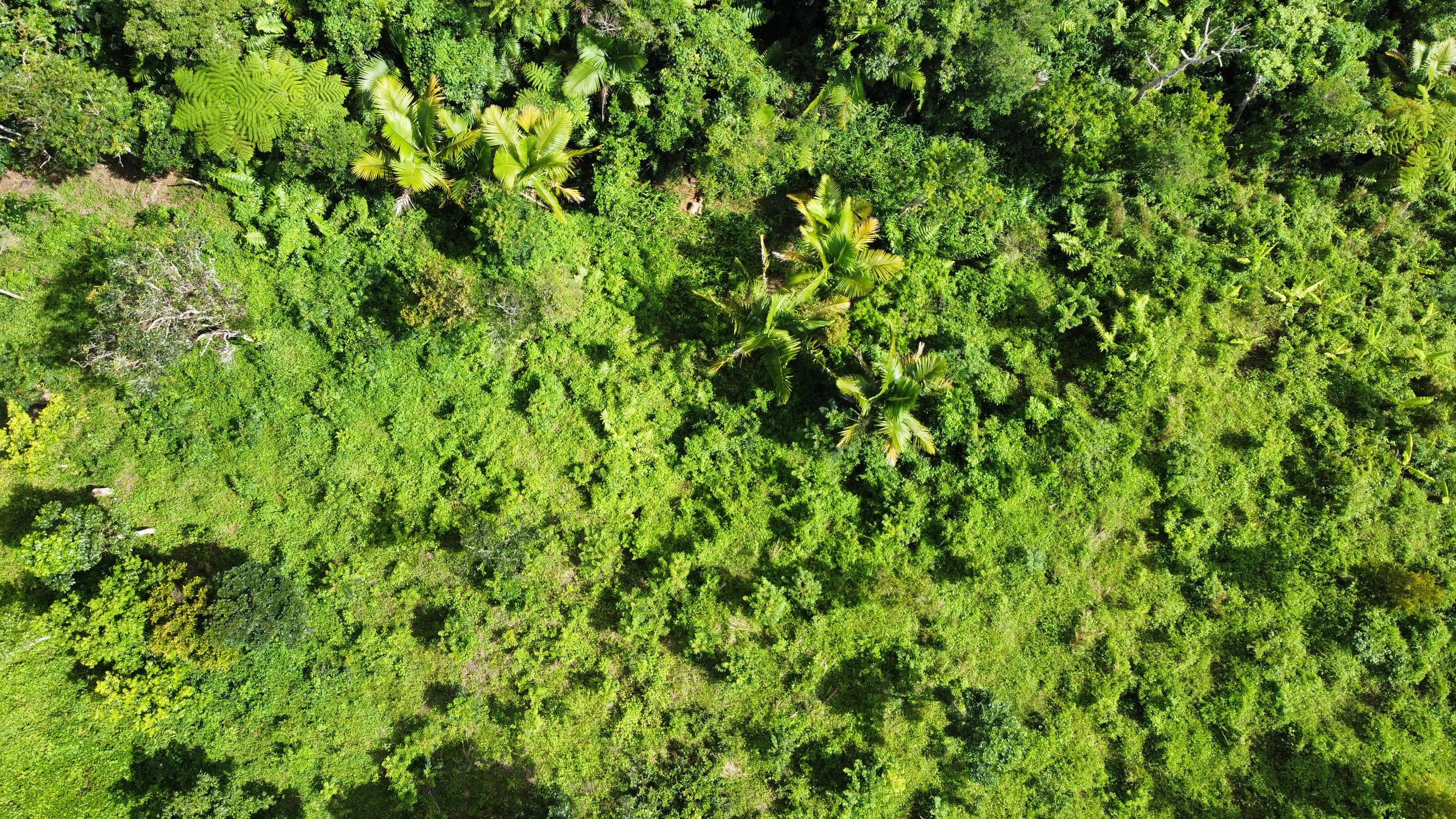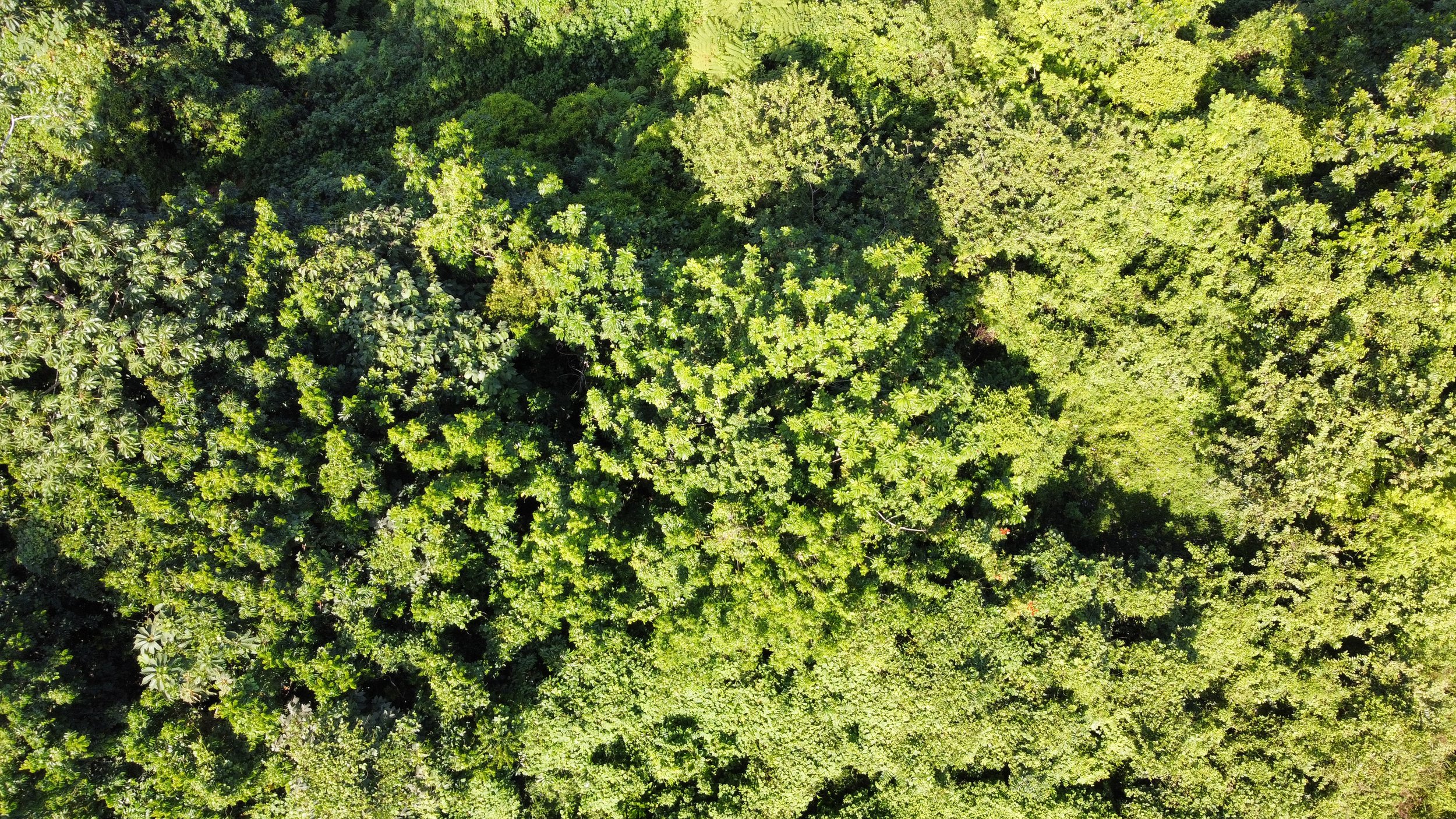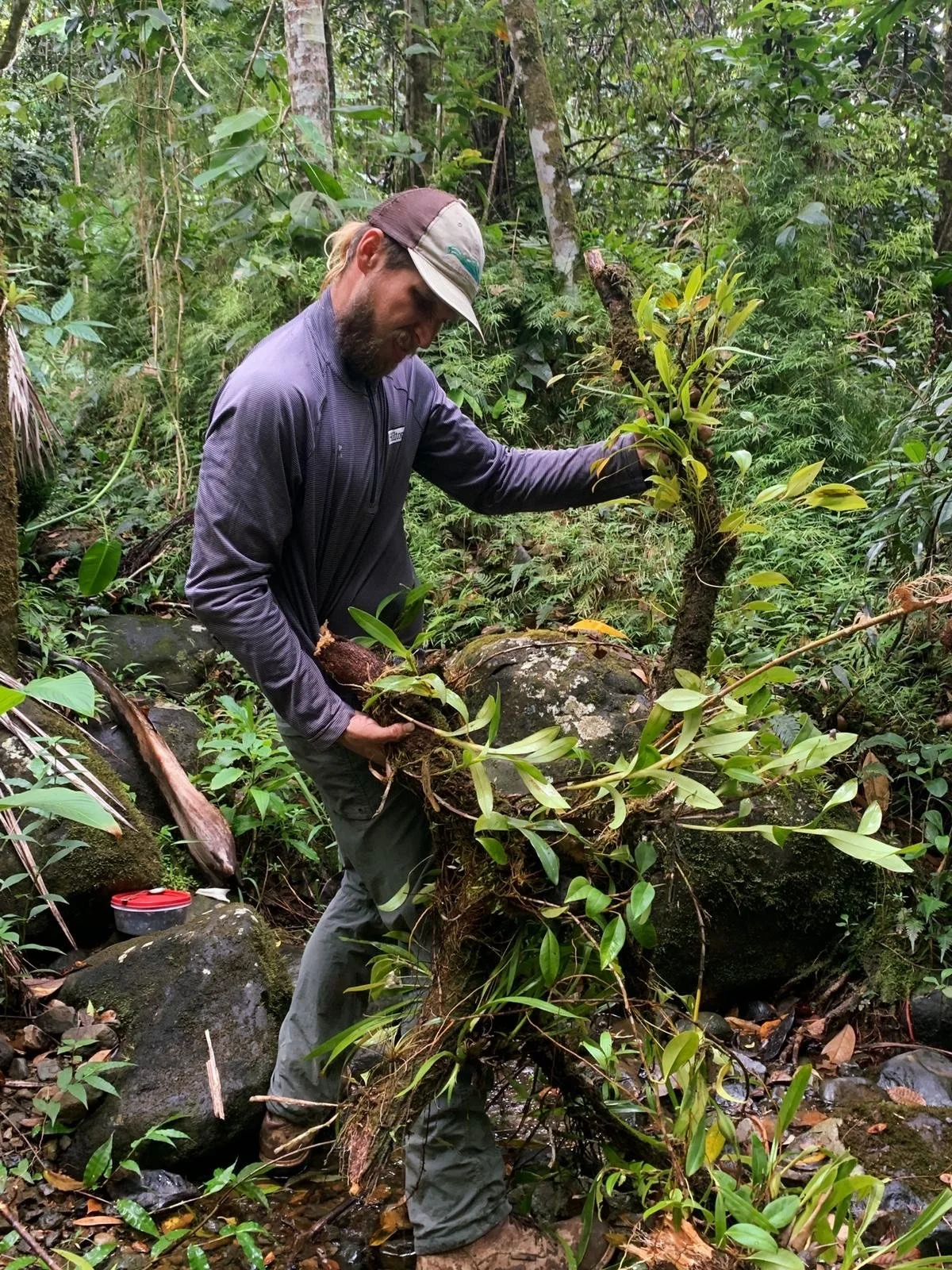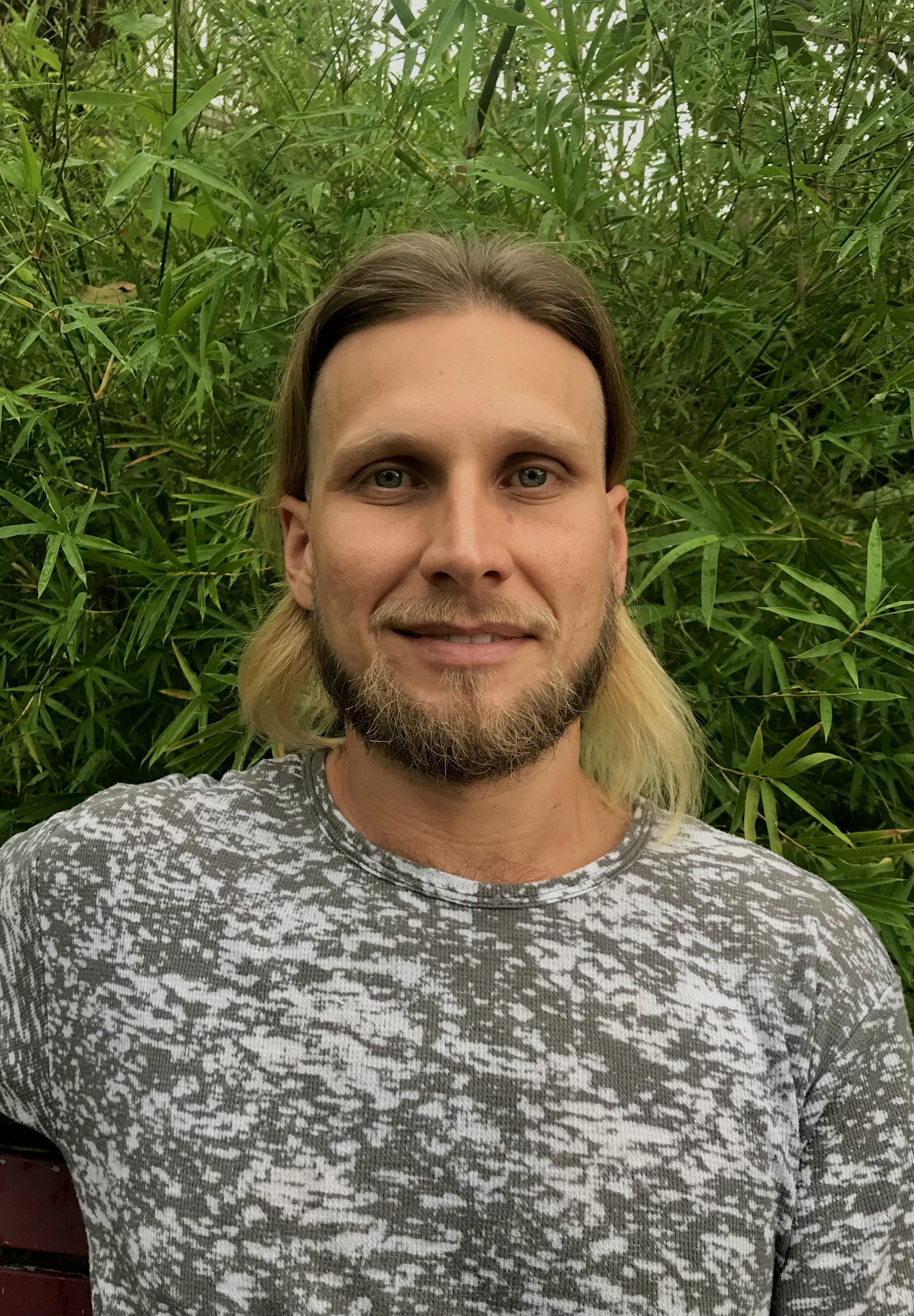Welcome Ayia Lindquist, new Ridge to Reefs staff!
Ayia Lindquist has roots in the Caribbean, born on the island of St. Croix, and raised along the shores of the Chesapeake Bay in Maryland. Her lifelong connection to these precious ecosystems informs her passion for environmental protection and restoration.
She received a Bachelor's degree in Geography with an emphasis in Environment and Society at San Diego State University in 2019. Through this program she became heavily involved in environmental justice issues on campus and out in the community, and worked with community gardens in Southeast San Diego. After college, she continued to follow the environmental justice path.
Ayia has worked in environmental education with the Smithsonian Environmental Research Center (SERC) and Patuxent Riverkeeper, creating curriculum for students living in frontline communities. She has worked in policy, serving as the community coordinator for Maryland District 30 for Senator Sarah Elfreth, and has been a volunteer with the Maryland Campaign for Environmental Human Rights. Most recently, Ayia has been working on Chesapeake Bay projects, including the Keystone 10 Million Trees Partnership, and she is a "Making History Campaign" Fellow with the Chesapeake Bay Foundation.
Ayia is passionate about climate solutions, particularly sustainable and regenerative agriculture. The pandemic served as an important catalyst for her to analyze where her food was coming from and the impact it has on the environment. This led her to begin working and volunteering with regenerative farms in her area. She is now the director of education for Wild Kid Acres, a biodynamic farm in Edgewater, Maryland. Ayia serves as an appointed member of the Anne Arundel County Agricultural Commission.
In her free time, Ayia loves to garden, travel, take care of her pets, and watch reality tv.
We are delighted to welcome Ayia to the Ridge to Reefs team!
Regenerative Agriculture & Drone Work In Puerto Rico!
Regenerative agriculture work continues in Puerto Rico!
Director of Agriculture and Sustainability Phal Mantha and Puerto Rico Project Coordinator Ricky Liquet-Gonzalez put in great effort together at the farm intervention sites. Ricky continues advancing healthy growth at these farms as we speak!
We are implementing regenerative agriculture practices with local farms. These methods help farmers work the land in a manageable, site-specific way that increases soil health, productivity, and crop yield. Agroforestry and sustainable agriculture methods not only regenerate the farm productivity that provides healthy food and supports local economies; these practices also support ecosystem health and hold land space for beneficial insects, reptiles, birds, and other wildlife.
Thanks to you - our support network, our farm and project partners, and funder USDA Conservation Innovation Grant!
Challenges & Solutions
The farm intervention areas are growing spaces where presently the farmers are having difficulty growing crops. Examples of some of the challenges include eroded soils, impacted soils, degraded soil microbiome, and too much or too little cover crop coverage. Each site is unique, with individual, specific opportunities and challenges.
Talking to the farmers about their desired outcomes, using scientific assessment techniques, assessing the health, status, and composition of the soils, and employing regenerative agriculture methods, we're working with local farmers to increase the health and productivity of their land.
New Technology
We are also excited to announce we have recently purchased a drone! Aerial views of these landscapes help us be far more specific in site-assessments than satellite-based topography images. This high-resolution and local detail helps us identify the contour lines essential for understanding water movement across the landscape. This helps with planning and design of regenerative agriculture practices. It also allows for amazing site comparison images - stay tuned as these farms grow!
Farm Intervention Sites & Regenerative Agriculture Plans
Stay tuned for developments and updates as efforts progress with these great farms! Follow us on social media for all the latest from the field.
Diwali, Deepawali - the Festival of Lights
Article written by Phalgun Mantha, Ridge to Reefs Director of Agriculture and Sustainability
Celebrating Diwali
"Diwali or "Deepavali" is the ancient Festival of Lights celebrated in India and around the world by practicing Hindus, Sikhs, Jains, and some Buddhists. The Holiday of Diwali has a variety of stories and mythologies associated with it, with the common theme being the victory of the forces of light over the forces of darkness. Most significantly, this Holiday represents the victory of knowledge over ignorance.
Growing up in a Hindu household, Diwali was always one of my favorite holidays during which my parents would buy me new clothes, bring home an assortment of fireworks, and make lots of traditional Indian food and sweets which would be shared and eaten with as many friends, neighbors, and family members as possible. During my childhood, it was always the fireworks that got me and the other children the most excited for Diwali. Fireworks are an integral part of Diwali Celebrations and have been used for thousands of years to celebrate this "Festival of Lights".
Fireworks Cottage Industry
In this context, it is interesting to note the ongoing battle over the use of fireworks during the Festival in India and beyond. Many state governments in India, including in the capital city of Delhi, have banned the sale and use of fireworks during Diwali citing climate change, air quality, and pollution concerns. While at a glance, this move may seem logical, in reality it is a rather short sighted move that has angered many people. Critics of the ban and restrictions on the use of fireworks during Diwali point out that India accounts for 17 % of the global population and yet only generates 6% of global emissions. On the other hand, the United States, with only a population of 330 million accounts for 11% of global emissions, and China with a population similar to India accounts for almost 25% of global emissions.
Furthermore, fireworks are a massive cottage industry in India which support the livelihood of a great many often low income people. These bans and restrictions not only change the traditional nature of Diwali celebrations, they also serve to further marginalize traditional cottage industries which support the livelihoods of many families.
Given that this is the case, many people feel that it is rather disingenuous to blame Diwali for air pollution and criticize fireworks restrictions which have been rolled out under the guise of Environmental Protections. Given that Diwali represents the victory of knowledge over ignorance, this holiday should be used to shed light on the main contributor to atmospheric pollution in India, especially in the National Capital Region (NCR) of Delhi.
Agricultural Stubble Burning
Stubble Burning. Photo Credit: Akhilesh Kumar, via The Hindu.com Newspaper
The primary cause of poor air quality in this region is the practice of "stubble burning" in the agricultural breadbasket regions of Punjab and Haryana. Farmers in these regions close to Delhi engage in the practice of stubble burning to remove agricultural residues after crops are harvested. It is estimated that farmers in Northern India burn 23 million tonnes a year of paddy stubble. A recent study estimated that crop residue burning released 149.24 million tonnes of carbon dioxide (CO2), over 9 million tonnes of carbon monoxide (CO), 0.25 million tonnes of oxides of sulphur (SOX), 1.28 million tonnes of particulate matter and 0.07 million tonnes of black carbon. These directly contribute to environmental pollution, human respiratory issues, and are also responsible for the haze in Delhi and the accelerated melting of Himalayan glaciers.
This Diwali, more light should be shed on the real elephant in the room- the practice of stubble burning. Viable solutions to address these issues should be highlighted and the light of knowledge and science should be used to elevate best practices.
Stubble Burning Solutions for Improved Soil Health & Productivity
Biochar - Thermal Power - Soil Amendments
Instead of burning stubble, Indian farmers should be encouraged and incentivized to remove and collect the biomass. This biomass can then be pyrolyzed and converted into biochar which can permanently sequester the carbon into the soil while improving soil fertility, agronomic productivity, and air quality.
In addition to biochar production, the collected agricultural stubble can also be used to generate briquettes for thermal power generation or even composted to create high quality soil amendments which can improve the farmer's soil health and agronomic productivity. All of these solutions would not only immediately reduce atmospheric pollution caused by stubble burning, they would also improve soil health and agronomic productivity on Indian farms.
Editorial Note: Ridge to Reefs respects the views and beliefs of all people. We value the thoughts of each individual on our team, and encourage respectful animated discussion on any subject. Statements reflected in staff articles may or may not reflect the position of the organization on policy issues. We fully support our staff and appreciate the richness of thought that comes from open discussion.
Welcome Ricardo Liquet-González, Agricultural Project Coordinator!
Ricardo (Ricky) Liquet-González is from the Caribbean archipelago of Puerto Rico. Ricky was born and raised in Mayagüez in the the western region of the main island. Growing up in an urban setting, Ricky experienced nature through the lush vegetation growing throughout Mayagüez.
Ricky attended the University of Puerto Rico with many interests, studying mycology, apiculture, forestry and agriculture. A professor at the University asked Ricky to run a soil ecology laboratory, kick-starting his career. During his years managing the soil lab, Ricky worked with all types of microscopic soil organisms. Ricky was offered a full scholarship for a master’s degree studying crop protection focusing on nematology.
By that point, Ricky was already aware of the damage the toxic chemicals inflict on the environment and the human body. He chose to focus his masters thesis on evaluating biological products for the control of endoparasitic nematodes in plantains. That experience opened multiple opportunities in multiple local agroecology and agroforestry projects.
When Hurricane Maria demolished the archipelago, Ricky immersed himself in social and community outreach projects, including Bosque Pachamama, Bambu-Pueblo & Bien Estar. He became completely committed to developing a stronger and more secure food system in Puerto Rico, and focused his efforts on community directed projects. When asked, Ricky says the work is hard but rewarding, and experiences in the field working with people is what keeps him going.
Presently, Ricky is engaged in interdisciplinary work tackling erosion and rainfall management with the use of innovative green infrastructure for tropical areas.
He is also developing an outdoor interpretative "classroom” as part of a joint multi-sector agroecology teaching center that will be launching by 2022. The outdoor classroom will be a setting for teaching agroforestry with focus on multi-story cropping, native habitat enhancement, riparian forest buffer management, and endangered species restoration program. The structure is sustainably integrated with edible species and timber bamboo worked into the system design.
When he’s not working on these projects, you can often find Ricky in the national forest gathering native seeds for propagation and plot trials, surfing on the west side of the island, or planning his next sustainable bamboo project. We’re delighted Ricky is bringing his skills and experience to the Ridge to Reefs team. Welcome, Ricky!
American Samoa Conservation Technician
We’re hiring!
Pago Pago, American Samoa On-site
Deadline: Nov. 15, 2023
Image Credit: American Samoa Government
Title: Conservation Technician
Location: Pago Pago, American Samoa
Classification: Full-time, three-year position with potential for extension
The USDA Natural Resources Conservation Service (NRCS) is seeking a qualified individual to serve as a Conservation Technician in the American Samoa field office, located in Pago Pago, American Samoa. Funding for this position is secured for (3) years with the potential of extension after (3) years under NRCS Pacific Islands Area Strategic Partnership Funding. The individual will work as a contractor for Ridge to Reefs, a 501c3 nonprofit organization partnering with NRCS, while reporting directly to the American Samoa NRCS District Conservationist.
ABOUT THE ORGANIZATION(S)
Ridge to Reefs is a 501c(3) non profit organization working in priority watersheds in the mainland U.S. and island territories to mitigate land-based sources of pollution to coral reef and coastal ecosystems. Our small team of scientists, engineers, ecologists and agronomists develops strong on-the-ground partnerships with local farmers, community leaders, politicians, organizations, businesses and entrepreneurs to create synergistic outcomes of conservation and sustainability. RTR specializes in implementing nature-based solutions to support clean water, healthy agricultural systems, and strong local economies. RTR currently works in Maryland, Virginia, Hawai’i, American Samoa, Palau, and Puerto Rico. In American Samoa, RTR is partnering with USDA NRCS on several projects to enhance conservation efforts, including the development and implementation of a Long-Range Plan and the hiring of a Conservation Technician.
The United States Department of Agriculture Natural Resources Conservation Service (NRCS USDA) helps America’s farmers, ranchers and forest landowners conserve the nation’s soil, water, air and other natural resources. All programs are voluntary and offer science-based solutions that benefit the landowner and the environment. NRCS provides technical and financial assistance to farmers and ranchers with interests in land and water conservation, habitat creation, water quality, and sustainable production improvements.
POSITION SUMMARY
The employee will be engaged in all aspects of providing conservation assistance to farmers, including but not limited to:
signing up farmers for EQIP and other Farm Bill programs
completing soil health management plans
implementing conservation practices (e.g. vegetative buffers, deep litter piggeries, composting)
consulting farmers on best conservation practices based on farmer needs and land conditions
performing environmental evaluations and soil tests
mapping potential sites for conservation
conducting cultural resource reviews
advancing objectives outlined in the American Samoa NRCS Long-Range Plan
collaborating with NRCS and partners to develop and implement sustainable strategies for local conservation efforts
engaging in education and outreach events to farmers and/or communities
developing requirements for the implementation of new or evolving conservation practices
using spreadsheets or other software to keep track of farmer data
communicating in-person and online with staff and partners
This position will include both office and field work; the exact percentage of time spent in each setting may fluctuate seasonally and is adaptable based on the employee’s skills and interests, however the employee should be competent in both field work and office work. The employee must have a valid driver’s license to drive NRCS’ vehicle to and from farm sites, and will occasionally travel by plane between Tutuila and Manu’a. The employee must have proficiency in the Samoan language and culture to ensure successful communication with farmers. Existing experience with farming, natural resource conservation, native plants and/or ecosystems is a plus.
REQUIREMENTS
Samoan language proficiency
Valid driver’s license
In process or completed Associate’s or Bachelor’s Degree in Agriculture, Natural Resources or related field, or demonstrated aptitude/background knowledge
Ability to work full days outside in a tropical climate
Ability to communicate effectively with farmers, staff and partners both in person and online
Ability to perform necessary office and paperwork
Passion for natural resource conservation and sustainable agriculture
Creative thinking and problem-solving skills
Willingness to learn new skills and ask questions
Self-motivated and flexible with changes in schedules and priorities
Great time and task management skills
Ability to pass a background check
COMPENSATION
The Conservation Technician will be compensated as a GS-5 federal employee. The technician will have a starting salary of $30,306 per year with additional fringe benefits for insurance, health care, vacation, sick leave, etc.
HOW TO APPLY
To apply, please submit an email with the subject “American Samoa Conservation Technician” to kelly@ridgetoreefs.org including a one-page resume with contact information as well as a brief explanation of your interest in the position, your current location of residence, and how your qualifications make you the ideal candidate for this position.
Ernesto Hevia del Puerto, co-founder of Cozumel Ocean Research
Celebrating Hispanic Heritage Month with Scientist Highlights
Ernesto Hevia del Puerto is an oceanologist, dive medical technician, and SCUBA instructor with more than 25 years experience in recreational, technical, scientific & cave diving. He is the head researcher & coordinator of the Cozumel spotted eagle ray project and has participated in many projects as research coordinator, expedition leader and aquatic safety supervisor. These include oceanographic projects, marine turtle conservation, photo identification of humpback whales, wildlife management & exploration and mapping of shipwrecks and underwater caves in Mexico and other destinations around the world.
Ernesto Hevia del Puerto is the co-founder of Cozumel Ocean Research, focused on the conservation and awareness of natural resources in Cozumel. He collaborates closely with Cozumel’s Marine National Park administration, working on reef conservation and restoration programs.
He is leading the study “Impacts of diving and snorkeling activities to Cozumel’s reefs.” COR also collaborates with the "Healthy Reefs for Healthy People" project, monitoring coral reef health, including studying coral bleaching and the recent outbreak of stony coral tissue loss disease (SCTLD) in the Mesoamerican Reef System. Visit Cozumel Ocean Research to learn more about their work!
#datanerd look at Chitosan Flocculant Sock Trials
Results
Check out these results! Data visualization is all about telling the story in the numbers. We're looking here at decline in turbidity in water samples. One sample (orange line) was a control, the other (blue line) was filtered through a chitosan flocculant sock (if you've just said "Whaaaaat?" read the previous blog post or rewind our social feeds to catch the methods mini series). Turbidity declines with application of the chitosan floc-sock, hooray for cleaner water and nature-based solutions!
Data Visualization
Check out the three figures here. They're showing the exact same data! The linear data shows each sample plotted against the measured NTU (a unit of turbidity, or the Nephelometric Turbidity Unit if you want to get really fancy). This shows the *amount* of change in turbidity, but doesn't really visualize the story - it's kind of hard to see the rate of change here. The two log scale plots show the *rate* of change between samples with different starting points (0 and 50 on the Y-axis). Whoa! Now the decline in turbidity (NTU) with samples measured through the flocculant sock really pops!
Your Thoughts!
Which data visualization do you like best? Contact us if you want to see data science content featured more often! We'll get back to you as soon as we've gotten our muddy shoes put away, and we appreciate your patience with replies from the field!




